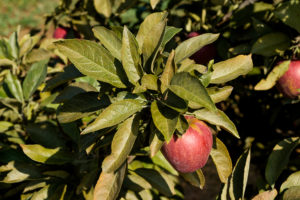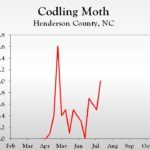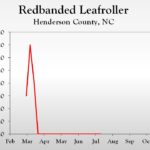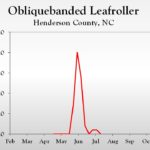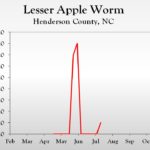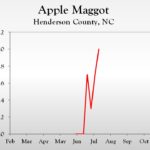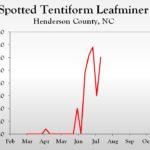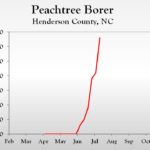WNC Orchard Insect Pest Populations – July 21, 2020
go.ncsu.edu/readext?712653
en Español / em Português
El inglés es el idioma de control de esta página. En la medida en que haya algún conflicto entre la traducción al inglés y la traducción, el inglés prevalece.
Al hacer clic en el enlace de traducción se activa un servicio de traducción gratuito para convertir la página al español. Al igual que con cualquier traducción por Internet, la conversión no es sensible al contexto y puede que no traduzca el texto en su significado original. NC State Extension no garantiza la exactitud del texto traducido. Por favor, tenga en cuenta que algunas aplicaciones y/o servicios pueden no funcionar como se espera cuando se traducen.
Português
Inglês é o idioma de controle desta página. Na medida que haja algum conflito entre o texto original em Inglês e a tradução, o Inglês prevalece.
Ao clicar no link de tradução, um serviço gratuito de tradução será ativado para converter a página para o Português. Como em qualquer tradução pela internet, a conversão não é sensivel ao contexto e pode não ocorrer a tradução para o significado orginal. O serviço de Extensão da Carolina do Norte (NC State Extension) não garante a exatidão do texto traduzido. Por favor, observe que algumas funções ou serviços podem não funcionar como esperado após a tradução.
English
English is the controlling language of this page. To the extent there is any conflict between the English text and the translation, English controls.
Clicking on the translation link activates a free translation service to convert the page to Spanish. As with any Internet translation, the conversion is not context-sensitive and may not translate the text to its original meaning. NC State Extension does not guarantee the accuracy of the translated text. Please note that some applications and/or services may not function as expected when translated.
Collapse ▲At lower elevations (<1000 ft), first generation brown mamorated stink bug is beginning to emerge, while at higher elevations second generation codling moth is of primary concern. San Jose scale infestations are beginning to appear on apples in trials at the research station in Mills River, so now would be a good time to scout orchards to determine if any adjustments in insecticides are needed.
Codling Moth & Oriental Fruit Moth
Degree-day (DD) accumulations in Henderson and Cleveland County are at about 1440 and 2000 DD, respectively. This suggests that now is an optimum time for an insecticide application in Henderson County (and similar elevations), while second-generation flight is nearing completion in lower elevation orchards. The exception would be in lower elevation orchards with high populations of codling moth, which would be indicated by high pheromone trap captures or recent larval infestations in fruit. In those orchards using mating disruption for codling moth, as well as those non-disrupted orchards that have had very low trap captures season-long, it is unlikely that insecticides are necessary at this time for codling moth. However, pheromone trap captures should be the key measuring stick. Oriental fruit moth pheromone trap captures have continued to be low at monitoring locations.
Brown Marmorated Stink Bug
Emergence of first-generation adults is beginning in Cleveland County and other locations of similar elevation (<1000 ft). To provide better clarity of BMSB emergence predictions for multiple locations, the model output is depicted in a different manner this week (see below). As of today (July 21), DD accumulations in Cleveland County are at 737, which the model predicts is equivalent to emergence of about 8% of the population. By next week that will have increased to almost 30%. Hence, now is an important time for managing this pest in lower elevations. Based on future weather forecasts, it will be at least a week before emergence begins in Wilkes County, and even longer in Henderson and Haywood Counties.
Other Pests of Potential Concern
Now is good time to scout those sections of orchards where San Jose scale has been a problem in recent years. SJS fruit infestations are now appearing in the non-treated controls of our insecticide trials on the research station. Hopefully, early-season treatments were effective in managing this pest in commercial orchards, but if not, detecting problems now and adjusting insecticide sprays will minimize expansion of infestations. European red mites continue to be detected across the region, but, in most instances, if populations have not developed by late July it is unlikely they will become a problem.
Finally, captures of apple maggot continue to be very low at our abandoned site; this insect typically begins to emerge in larger numbers in late July to early August.
[Update] Dinotefuran Section 18 Request for Pome and Stone Fruits Approved
Details online.
Learn more about southeastern apple insect pests at the Apple Insect Management page.
2020 Average Weekly Trap Captures
| HENDERSON COUNTY | |||
| Insects per trap | |||
| Jul 6 | Jul 13 | Jul 20 | |
| Codling moth | 0.6 | 0.5 | 1.0 |
| Oriental fruit moth | 4.4 | 3.3 | 2.9 |
| Tufted apple bud moth | 3.0 | 0.0 | 0.0 |
| Redbanded leafroller | 0.0 | 0.0 | 0.0 |
| Obliquebanded leafroller | 1.0 | 1.0 | 0.0 |
| Lesser appleworm | 0.0 | 0.0 | 1.0 |
| Apple maggot (abandoned and research orchards) | 0.3 | 0.7 | 1.0 |
| Brown marmorated stink bug (commercial) | 0.8 | 1.1 | 1.2 |
| Brown marmorated stink bug (unsprayed) | 2.8 | 1.8 | 4.3 |
| Spotted tentiform leafminer | 34.0 | 15.0 | 30.0 |
| Dogwood borer | 42.0 | 28.0 | 9.0 |
| Peachtree borer | 19.0 | 21.0 | 33.0 |
| Lesser peachtree borer | 42.0 | 35.0 | 33.0 |
| San Jose scale | 1895.0 | 785.0 | 1172.5 |
*Note that these averages illustrate only the timing of insect emergence and fluctuations in populations, and are not representative of population levels in any given orchard. The only way to have an accurate assessment of an individual orchard’s populations is to set up traps in that orchard.
2020 Accumulated Degree Days
| HENDERSON COUNTY | ||||
| Jul 6 | Jul 13 | Jul 20 | ||
| Codling moth (Biofix 4/20) | 1088 DD | 1246 DD | 1406 DD | |
| Oriental fruit moth (Biofix 3/30) | 1626 DD | 1818 DD | 2008 DD | |
| Tufted apple bud moth (Biofix 4/27) | 1368 DD | 1560 DD | 1750 DD | |
2020 Pest Trends (click to enlarge)
Visit WNC Orchard Insect Populations for archived posts.



